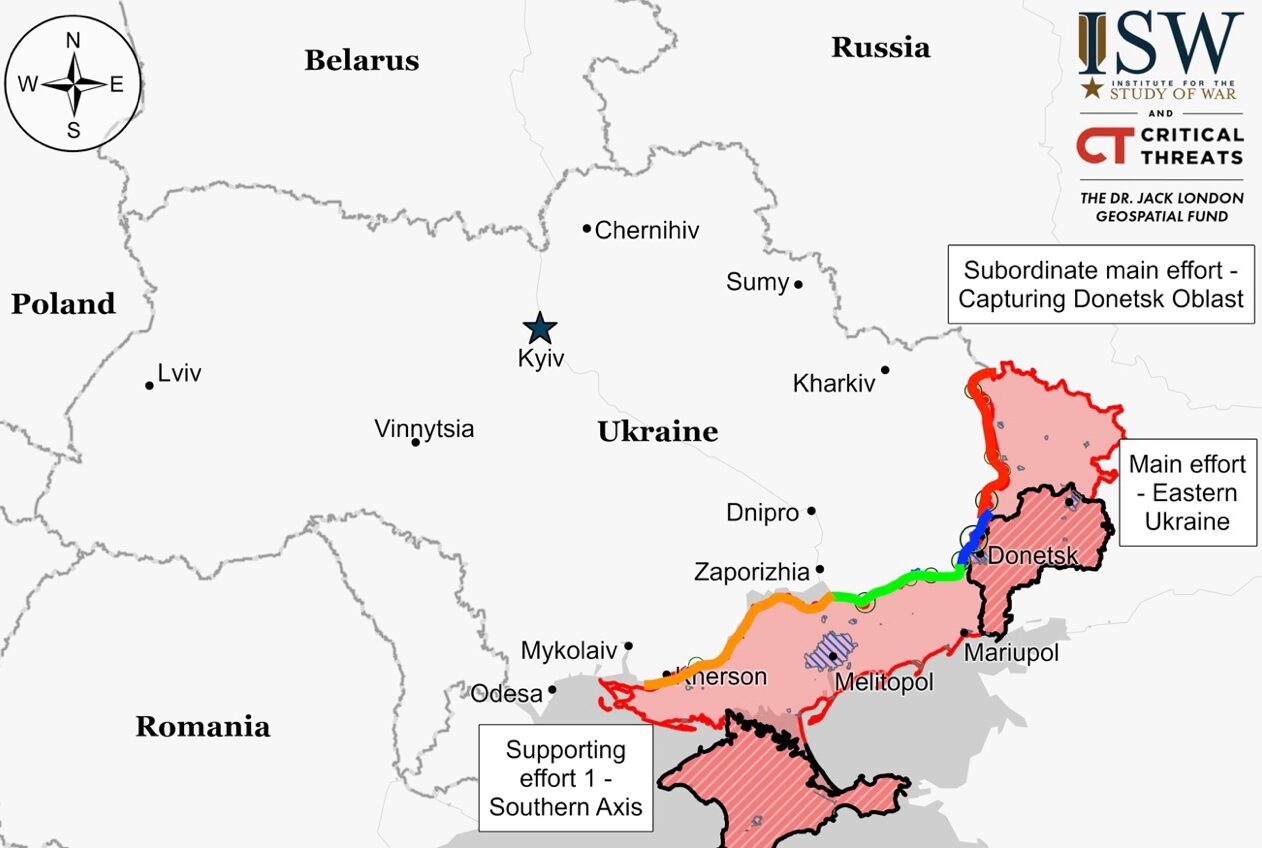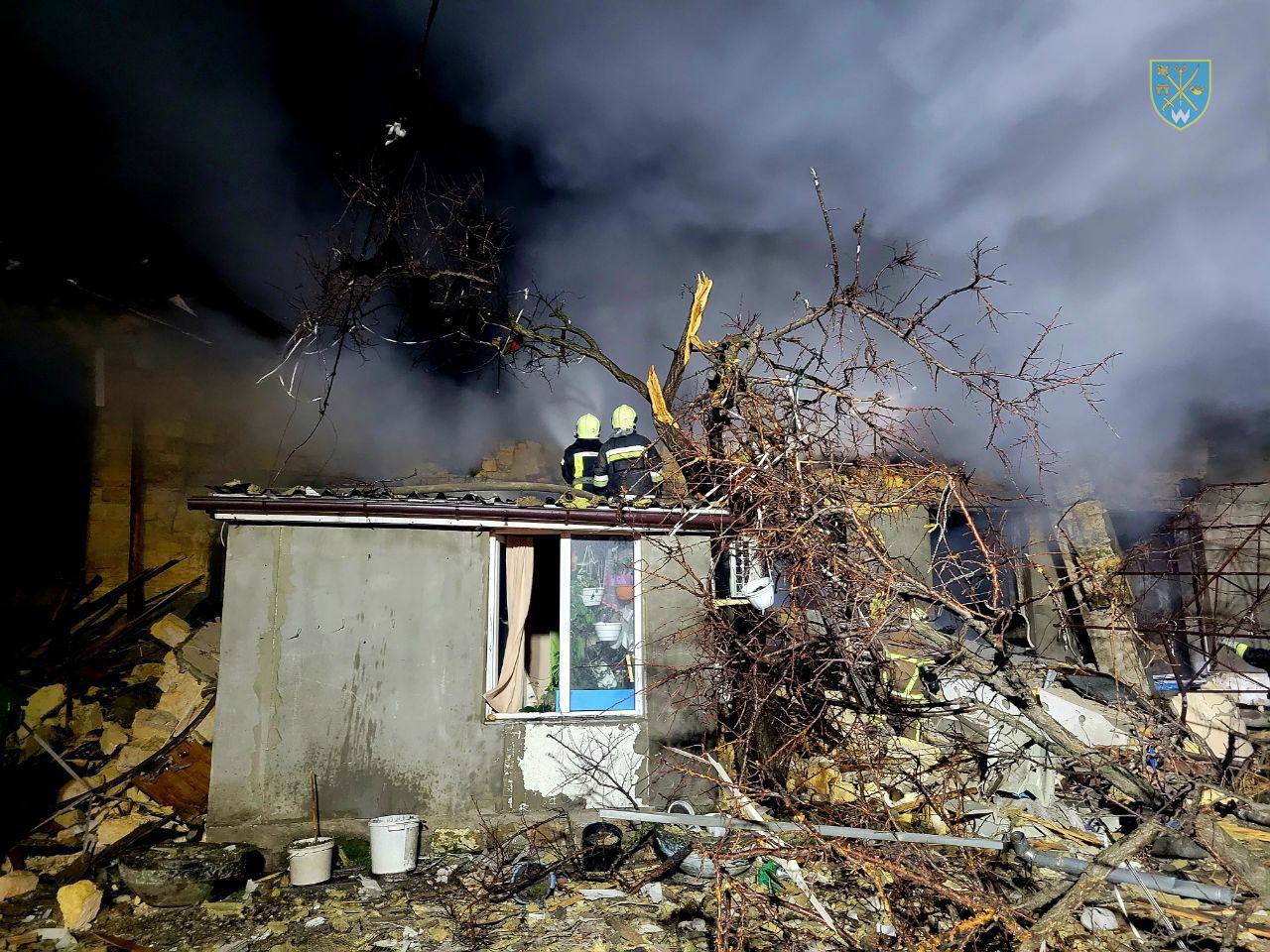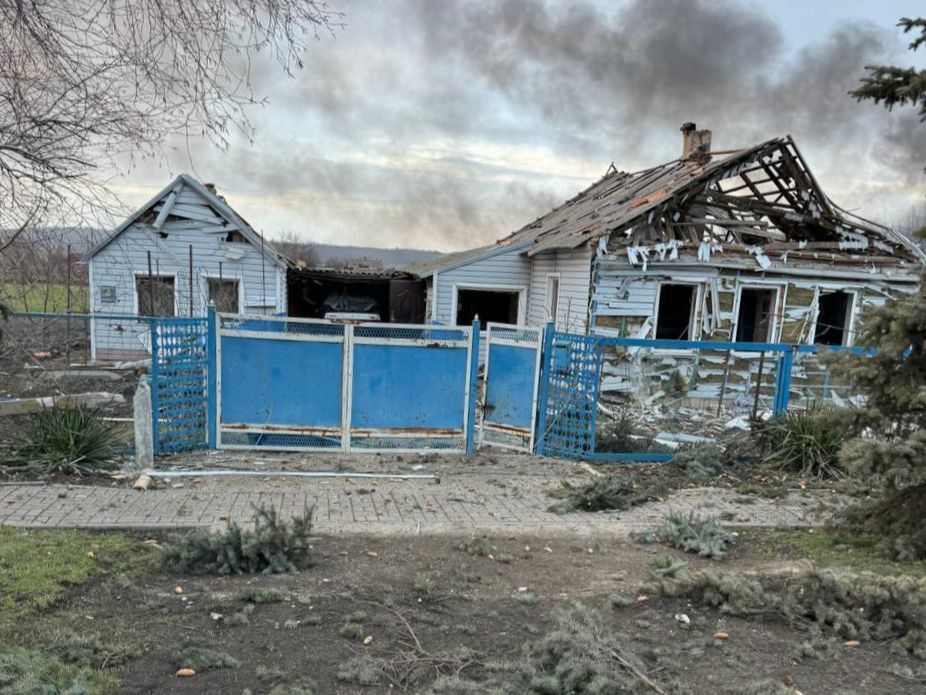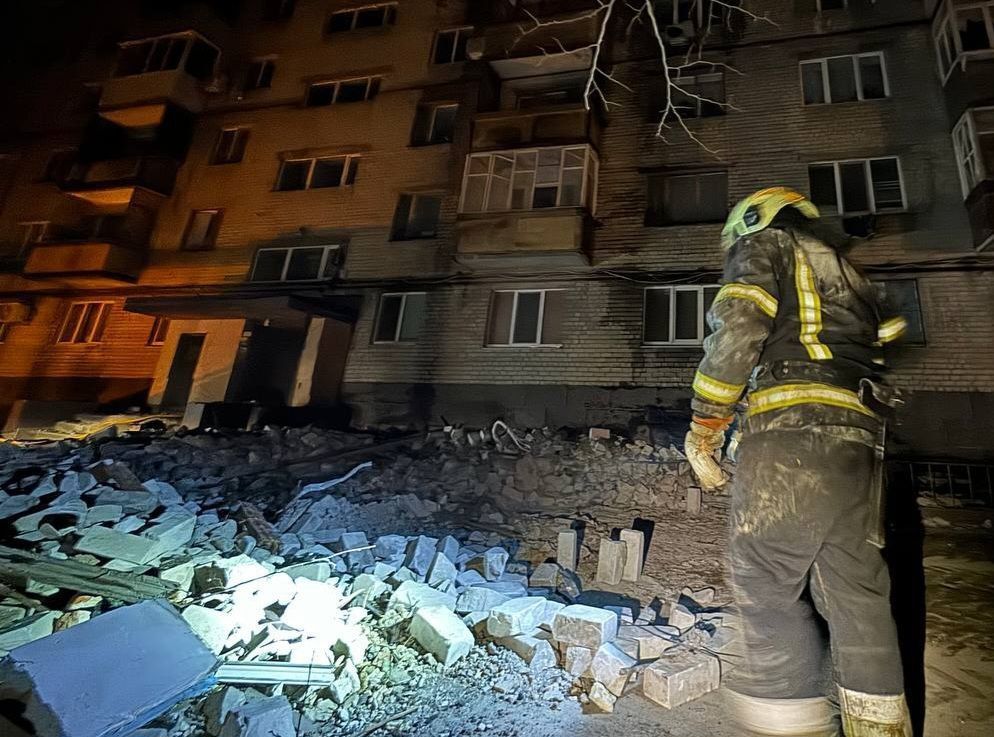Summary of the day: Dmitry Medvedev has suggested that Russia may target further territorial gains in Ukraine, including Kyiv and Odesa. Ukrainian forces struck a Russian base in Kherson, while Western nations increased military aid to Ukraine. The Kremlin faced internal challenges with a significant number of Russians charged with political offenses and distanced itself from military bloggers after one’s suicide. Russian troops have advanced in the Bakhmut and Avdiivka regions.
Situation On The Ground And Air
Roman Holodivskyi of Ukraine’s 43rd Artillery Brigade noted Russia is using ammunition produced in 2022 and 2023, indicating a steady supply. In contrast, Ukraine faces a severe artillery shell shortage, exacerbated by delayed U.S. funding. The situation was highlighted by Ukraine’s recent retreat from Avdiivka, underscoring the need for more military support. Ukrainian forces are limited in shell usage, often receiving less than required for effective defense. Meanwhile, Russia continues to produce and refurbish large quantities of ammunition, potentially widening the gap in artillery capabilities between the two nations in 2024.
Ukraine is on the brink of a severe ammunition and air defense crisis by late March without $61 billion in aid from Congress, according to U.S. officials. The shortage could shift the war’s momentum to Russia. Jake Sullivan and other U.S. officials emphasize the urgency, with recent Russian advances underscoring the immediate need for military support. The situation threatens not only Ukraine’s frontline defenses but also its ability to protect against aerial attacks, highlighting a critical period ahead for Ukrainian resistance.

Luhansk Front – Initiative Russia
Donetsk Front – Initiative Russia
Zaporizhia Front – Initiative Russia
Kherson (Dnipro River) Front – Initiative None
Positional battles persisted along the Kupyansk-Svatove-Kreminna line without any confirmed shifts in the frontline. Engagements took place in several locations around this area, involving Russian forces in the vicinity of Bilohorivka.
Russian forces have made slight advances in the northwest of Bakhmut amid ongoing positional battles in the region. The engagements have been concentrated around several areas in and around Bakhmut, with both sides maintaining their positions in most locations. The situation reflects the continued intensity of the conflict in this strategic area.
Russian forces have reportedly made advancements west of Avdiivka and claimed to have captured Sieverne southwest of the area. Despite these claims, ongoing positional battles continue around Avdiivka, indicating sustained conflict intensity. Separately, a Ukrainian military analyst highlighted significant Russian equipment losses in the Avdiivka campaign, noting an unprecedented scale of tank and armored vehicle losses compared to historical conflicts, suggesting a potential shift towards infantry-focused tactics in response.
Positional battles persisted around Donetsk City with no significant shifts in the frontline reported. Russian forces are noted to have made slight progress towards Krasnohorivka, while the capture of Pobieda by Russian forces has been officially confirmed. The conflict continues in areas west and southwest of Donetsk City, reflecting ongoing tensions in the region.
Positional engagements were reported in the Donetsk-Zaporizhia Oblast border area, with Russian forces claimed to have made advances near Novodonetske and Pryyutne. The conflict continues in areas south and southwest of Velyka Novosilka, reflecting ongoing tensions in the region.
Russian forces were reported to have made advances in western Zaporizhia Oblast, with specific progress noted near Robotyne and Verbove. Continuous fighting has been observed in the vicinity of these areas, signaling ongoing conflict dynamics in the region.
In east bank Kherson Oblast, particularly near Krynky, positional fighting continued with reports of Russian forces retreating from certain positions following a Ukrainian assault. This development indicates ongoing military engagements in the region.
Human Costs Of War
In the past 24 hours, Russian attacks on civilian targets in Ukraine caused five deaths and injured at least 17 others:
- A Russian drone strike on Odesa resulted in the deaths of three civilians. The attack also caused a fire, with one body initially found at the scene and two more later recovered from debris. Despite air defenses intercepting nine drones, one drone struck a coastal building, leading to a fire and the rescue of a security guard. Some missiles launched by Russian forces lost their combat capability before reaching their targets.
- A Russian assault on Kostiantynopolske in Donetsk Oblast resulted in one death and nine injuries, including four children. The village, located near the frontline, was struck by rockets in the late afternoon. Authorities indicate the weapons used were likely Uragan launchers with fragmentation warheads. The casualties, some with burn and shrapnel wounds, are being treated, and several homes were damaged in the attack.
- Dnipro was hit by Russian Shahed drones, resulting in at least eight injuries and damage to a high-rise building, with potential victims trapped in the rubble.
- A Russian strike in the morning on the village of Lvove in Kherson Oblast resulted in the death of a 59-year-old man. The man was killed at his residence during the attack.
 Aftermath of Russian drone strike on civilian targets in Odesa
Aftermath of Russian drone strike on civilian targets in Odesa
 Aftermath of a Russian attack on civilians in the village of Kostiantynopolske
Aftermath of a Russian attack on civilians in the village of Kostiantynopolske
 Aftermath of a Russian drone attack on a multi-story apartment building in Dnipro
Aftermath of a Russian drone attack on a multi-story apartment building in Dnipro
Ukraine News
Ukrainian forces struck a Russian training ground in occupied Kherson Oblast, reportedly killing nearly 60 Russian servicemen. The strike targeted Russian units in Podo-Kalynivka as they prepared for operations near Krynky. Russian military bloggers criticized their command’s vulnerability to Ukrainian drones and HIMARS, calling for improved training policies to better shield servicemen from such strikes.
Russian forces carried out a drone and missile strike against Ukraine, launching 10 drones and an anti-radar missile, with eight drones shot down by Ukrainian forces. A missile targeted Odesa Oblast, and the Myrhorod military airfield in Poltava Oblast was reportedly struck. Additionally, Ukraine’s Security Service revealed that over 20 North Korean ballistic missiles have been used by Russia in strikes against Ukraine, including attacks on Zaporizhzhia City, an apartment building in Kyiv, and civilian infrastructure in Donetsk and Kharkiv oblasts.
In an interview with Fox News, Ukrainian President Volodymyr Zelensky, speaking from the Kharkiv Oblast frontline, rejected the notion of a stalemate in the conflict with Russia. He indicated that Ukraine is planning new operations and has had success against the Russian Black Sea Fleet. Zelensky claimed that Russian battlefield losses are five times greater than Ukrainian casualties. The interview comes as Ukraine faces a delay in U.S. funding, which has impacted the war effort and coincided with Ukrainian troops’ recent withdrawal from Avdiivka. Zelensky emphasized the need for long-range weapons from Western partners to counter Russian forces and stressed the urgency of quick action to save lives, cautioning against the global implications of a Russian victory.
Nearly a third of Ukraine’s population, over 14 million people, have been displaced since the onset of Russia’s full-scale invasion two years ago, with 3.7 million internally displaced and about 6.5 million as refugees abroad. The International Organization for Migration notes that while 4.5 million have returned to Ukraine, the crisis continues with significant numbers still needing humanitarian aid both within Ukraine and in neighboring countries. Despite the challenges, more than half of the refugees hope to return to Ukraine eventually.
Ukraine’s Allies
The White House has reproached House Republicans for not advancing aid for Ukraine, highlighting the issue in a memo that labels the GOP’s recess as detrimental to American national security. Despite a bipartisan Senate bill approving $60 billion for Ukraine, the House adjourned without a vote, causing aid to stall. With concerns over Russian military progress following Ukraine’s withdrawal from Avdiivka, the White House criticizes the recess prioritization over pressing international security needs. House Republicans counter with a focus on domestic issues, particularly the southern U.S. border. A potential meeting between President Biden and House Speaker Mike Johnson is being considered to resolve the impasse. Congress is expected to reconvene on February 28.
U.S. President Joe Biden will impose sanctions on Russian President Vladimir Putin following the death of Russian opposition leader Alexei Navalny. The announcement came after Biden met with Navalny’s family, expressing admiration for Navalny’s courage. Navalny died under controversial circumstances in a penal colony, leading to international calls for accountability, including from the EU for an independent investigation. The U.S. sanctions aim to directly target the Russian military infrastructure involved in Navalny’s death.
The U.K. has committed to sending Ukraine an additional 200 Brimstone anti-tank missiles, as announced by Defense Secretary Grant Shapps. Each missile costs about £100,000 and is known for its accuracy and effectiveness against moving targets, including tanks. These weapons, which can be launched from both air and ground platforms, have been previously utilized by Ukrainian forces, notably in innovative ways such as from modified trucks. Shapps highlighted their significant battlefield impact, citing an instance where Russian forces were forced to retreat. The U.K. ranks as the third-largest provider of military aid to Ukraine, contributing 9.1 billion euros to date.
Denmark, in coordination with the US Department of Defense, has stated that Ukraine will receive its first delivery of F-16 fighter jets by this summer as part of an aid package aimed at bolstering Ukrainian air capabilities. Despite potential delays and the complexity of preparations, the Danish Defense Minister has indicated that the process is being expedited for delivery this summer if all goes according to plan. This effort is part of a broader commitment by several European countries to supply Ukraine with advanced fourth-generation jets.
Denmark has committed to a 10-year security assistance agreement with Ukraine, highlighting its dedication to supporting Ukraine against Russian aggression with over $10 billion earmarked through its Ukraine Fund. This move aligns Denmark with other nations like the U.K., Germany, and France, which have entered similar agreements. Denmark’s latest aid package includes $247 million worth of military support, such as ammunition and drones, emphasizing the long-term nature of this commitment. This support is crucial as the conflict enters its third year, with Denmark standing as a significant military aid provider in terms of GDP percentage, reinforcing the international effort to sustain Ukraine’s defense capabilities.
New Zealand announced $15.4 million in aid, covering humanitarian support and funds for Ukraine’s weapons procurement and reconstruction efforts.
Latvia has decided to ban the import of grain products from Belarus and Russia, marking itself as the first EU country to implement such a measure. This decision follows a significant increase in Russian grain imports through Latvia in 2023, amidst protests by local farmers and concerns over the economic and political implications of these imports. Latvian President Edgars Rinkevics and lawmakers have cited the move as both a moral and economic stance against supporting the Russian regime, suggesting that some of the grain might be stolen from Ukrainian territories. The ban is set to take effect in two weeks, with specific details on the affected products to be outlined by the government.
The German parliament addressed the issue of supplying long-range weapons to Ukraine, rejecting a proposal for Taurus missile delivery but approving additional unspecified long-range weaponry. The Taurus, with a 500-kilometer range, has been a focal point of debate, with Chancellor Scholz expressing concerns over Germany’s direct involvement in the conflict. Despite this, Ukraine has received similar missiles from other European nations. The motion for Taurus missiles was notably opposed by the ruling coalition, save for a dissenting vote from FDP’s Marie-Agnes Strack-Zimmermann, who emphasized the importance of supporting Ukraine against Russia. A subsequent motion, backed by the coalition, for further long-range weapon support was approved, highlighting Germany’s continued, albeit cautious, aid to Ukraine.
A recent survey by RMF24 revealed that nearly half of Poles consider a Russian attack on Poland likely, reflecting heightened concerns over the risk of conflict between Russia and NATO. The survey also showed pessimism regarding Ukraine’s chances of victory, with only a small percentage believing in its success. Similar sentiments were found in European and American polls, indicating a widespread perception of a prolonged conflict. Amid uncertainties about U.S. commitment to NATO, Poland aims to bolster its armed forces significantly, with plans to expand its army to 300,000 soldiers, becoming Europe’s largest land army.
Polish Prime Minister Donald Tusk declined President Zelensky’s proposal for a border meeting to address the farmer-led blockade, citing an already planned government meeting in March. The blockade, triggered by farmer protests against Ukrainian imports and the EU’s Green Deal, has escalated, posing security risks and disrupting supplies to Ukrainian soldiers. Zelensky seeks dialogue, emphasizing a pragmatic resolution, while Tusk pledges support for farmers and aims for protective solutions. Poland also plans to designate critical infrastructure to ensure aid reaches Ukraine efficiently and vows to combat Russian propaganda.
Life in Russian Occupied Ukraine
Dmitry Medvedev outlined plans for the repression of Ukrainian citizens in Russian-occupied Ukraine, suggesting those who oppose Russia should be “sent to Siberia for re-education in forced labor camps,” echoing Stalin-era purge tactics. This rhetoric aligns with actions and statements from occupation authorities, like Zaporizhia’s governor Yevgeny Balitsky, who discussed forced deportations and hinted at harsher measures against those resisting the occupation.
Russia has extended its policies of religious persecution to occupied Ukraine, with a recent raid on a Jehovah’s Witness congregation in Mariupol, Donetsk Oblast, led by the FSB and Rosgvardia. Over 5,000 books were seized in the operation. Since 2017, Russia has labeled Jehovah’s Witnesses as “extremist,” leading to ongoing persecution of this and other religious minorities within Russia and Ukraine.
Russian authorities have deported 20 Ukrainian children and their mothers from occupied Luhansk Oblast to a sanatorium in Moscow Oblast, as part of purported rehabilitation programs. This action is part of ongoing illegal deportations of Ukrainian civilians to Russia.
Russia News
Russian President Vladimir Putin, alongside leaders from the Commonwealth of Independent States (CIS) and the Head of the Republic of Tatarstan, Rustam Minnikhanov, participated in the “Games of the Future” in Kazan. During this time, Putin also discussed the development of a new research center in Tatarstan with Minnikhanov and former Tatarstan head Mintimer Shamaiev. Notably, Minnikhanov’s recent visit to Iran, aimed at discussing defense cooperation, aligns with Tatarstan’s involvement in military drone manufacturing and connections to pro-Russia regions like Gagauzia in Moldova, amidst warnings of potential Russian operations against Moldova.
Proekt, a Russian opposition outlet, reported a significant increase in political repression in Russia, with the government charging at least 116,000 citizens for various offenses since 2018. This includes tens of thousands facing politically motivated charges, such as extremism and spreading “fake” information about the war in Ukraine. The report highlights the Kremlin’s growing use of the criminal justice system to quell dissent and strengthen its control amidst the ongoing conflict.
Kremlin spokesperson Dmitry Peskov differentiated between Russian military correspondents and actual combatants in the conflict in Ukraine, stating that correspondents should not be equated with armed servicemen. This statement came after the suicide of a well-known Russian military blogger who was critical of the military command. The Kremlin appears to be tightening its grip on the narrative by emphasizing official military correspondents and potentially sidelining independent milbloggers who have taken on roles beyond reporting.
A survey by the Kremlin-affiliated Public Opinion Foundation indicates that 68% of Russians view military professions as highly prestigious, showing a consistent rise from 53% in 2022 to 60% in 2023. The survey’s findings, aimed at promoting military recruitment, suggest an increasing public perception of the military’s prestige in Russia.
Russian Mobilization and Defense Industrial Base
Plans to form Rosgvardia’s 1st Volunteer Corps from former Wagner Group detachments have been delayed due to the redeployment of these personnel to Africa. This adjustment comes amidst reports of halted efforts to integrate Wagner personnel into Rosgvardia, reflecting a shift in the utilization of these forces.
The Russian design bureau “Stratim” announced plans to test the “Chaika” drone in Ukraine by March 2024. Described as a tail sitter drone, the Chaika is designed to blend the benefits of fixed-wing aircraft and multi-rotor UAVs, boasting a range of up to 30km, speeds of at least 100km per hour, and a payload capacity of 4-5 kilograms.
Russian Allies
Belarus is enhancing its military collaboration with Russia, developing a framework for joint combat training centers and proposing a unified weapons program. The nations plan to continue their routine biennial military exercises in 2025. Additionally, Belarus aligns with Kremlin claims, suggesting Ukraine is a significant threat, alleging the concentration of Ukrainian forces near their border and the potential for cross-border provocations.
Russian Narratives for Propaganda
Russian President Vladimir Putin and Kremlin Spokesperson Dmitry Peskov have reinforced narratives justifying the invasion of Ukraine and claimed the Russian economy remains stable under Western sanctions. They described the military actions as “liberating” historical lands and addressing threats in Donbas and “Novorossiya.” Putin also asserted that Russia’s regions, including annexed Ukrainian territories, possess strong economic growth potential.
Dmitry Medvedev indicated that Russia may aim to capture Kyiv and further territories in Ukraine to achieve its military objectives, including “demilitarization” and “denazification.” He also mentioned the potential reduction of Ukraine to a smaller state and emphasized historical Russian claims to Ukrainian cities like Kyiv and Odesa, aligning with the Kremlin’s narrative of reclaiming “historic lands.”
Dmitry Medvedev hinted at Russia’s interest in occupying Odesa, coinciding with developments in Transnistria, a pro-Russian region in Moldova near Odesa. Transnistria’s Congress plans to meet, potentially to discuss annexation by Russia, echoing a 2006 referendum. However, there’s no clear sign of Russian military moves towards Transnistria or Moldova, which would be logistically challenging due to their landlocked positions and access only through Romania or Ukraine.
Russian Foreign Minister Sergei Lavrov attributed the absence of peace negotiations for the war in Ukraine to Western “arrogance and pre-occupation with Russophobia.” This stance contrasts with official Russian declarations indicating a lack of interest in engaging in genuine peace talks with Ukraine.
Source Materials
Institute for the Study of War – understandingwar.org.
The Kyiv Independent – kyivindependent.com.
